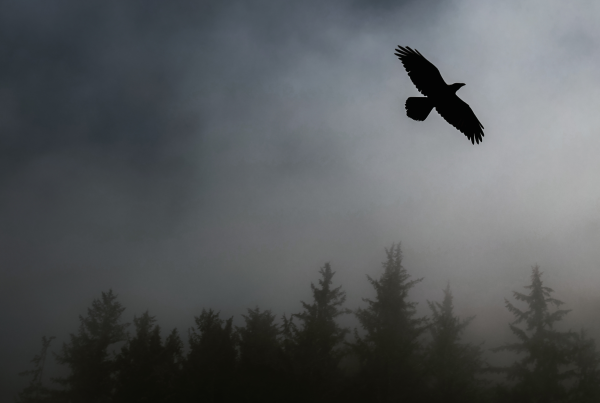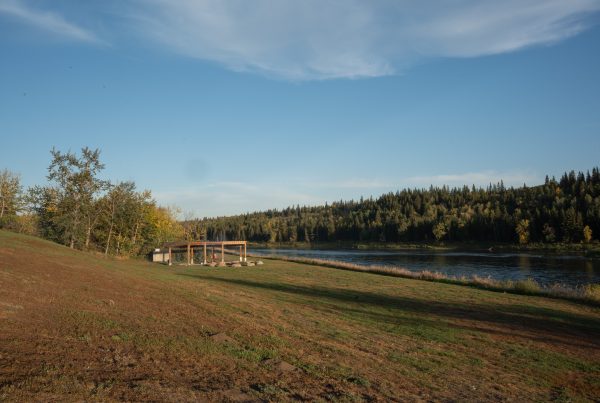On July 11, 2024, Kebaowek First Nation finished their oral arguments in court against the Canadian Nuclear Safety Commission (“Commission”). They argued over the approval of a Near Surface Disposal Facility (NSDF) on their territory, which would hold over one million cubic tonnes of nuclear waste just one kilometre away from the Kichi Sibi (Ottawa River). Kebaowek wants the NSDF’s location to be reconsidered as part of what they view as an obligation to protect their territory.
This case is about much more than the NSDF. The applicability of UNDRIP in Canadian law is considered in this case. Incredibly important questions were asked:
- When the Commission approved the NSDF, should they have gotten the free, prior, and informed consent (FPIC) of Kebaowek First Nation because Canada passed the United Nations Declaration on the Rights of Indigenous Peoples Act (UNDA) in 2021?
- Is FPIC required to fulfill the Honour of the Crown and, therefore, should be a part of the consultation process?
- Does the Commission have the jurisdiction to decide such matters?
These questions will have ripple effects throughout Canadian law when answered. Multiple cases ask similar questions about the applicability of UNDRIP in Canadian law with answers that are being contemplated by various levels of court. Will Kebaowek’s case recognize that federal law needs to uphold UNDA?
The Facts
Canadian Nuclear Laboratories (CNL) operates a large nuclear development and research facility on 37.5 square kilometres of land in Chalk River, Ontario. Opened during the Second World War, the site contributed to research behind the atomic bombs that were dropped on Hiroshima and Nagasaki in 1945. North America’s first nuclear reactor meltdown later occurred here in 1952 (you can read our blog about the meltdown for the full story). The facilities are now important for creating medical isotopes to treat heart disease and different types of cancers.
Kebaowek First Nation, and members of the Algonquin Nation at large, have been excluded from the Chalk River site since 1940. Fences and security personnel have prevented them from practicing their hunting, fishing, and harvesting rights.
Over 70 years of nuclear research and development has produced a lot of waste. From rods blasting apart from a nuclear core meltdown to low level amounts of radiation contaminating gloves and suits, all of the waste has to be contained. How that waste has been handled and stored in the past is considered dangerous to human health, the natural world, and wildlife in the area.
CNL wants to build the NSDF to store low-level nuclear waste at the site and from other institutions in Ontario, such as universities and nuclear energy sites. The NSDF project would transform 37 hectares of old forest (equivalent to 37 football stadiums) into an advanced technological facility that would store low-level nuclear waste, including a wastewater treatment facility and several layers of membrane to contain the radioactivity of the waste. The facility is proposed 1.1 kilometres from the Kichi Sibi; all of the nuclear research and development facilities were built right on the Kichi Sibi to provide a constant source of water for reactor cooling, so the NSDF is proposed nearby where there’s the most nuclear waste. It would operate for 50 years, but permanent exclusion from the site would last 300 to 500 years (which, as noted by Kebaowek in their arguments, is longer than European contact with Indigenous Nations). The land would be permanently altered as a result of the NSDF project.
The duty to consult was triggered by the proposal for the NSDF, meaning the Federal government, in this case the Commission, had a duty to ensure that the relevant First Nations were sufficiently consulted. This was done by requiring the proponent (CNL) to engage with First Nations to consult them about how their rights would be affected by the project, and accommodate them if necessary. Kebaowek First Nation was one of the First Nations that was consulted over the project.
The consultation process was extensive, as is required according to the Crown’s obligations to First Nations under the Haida test (a past court case that established the spectrum of consultation in which governments must conduct in order to fulfill the duty to consult). There were meetings, phone calls, site visits, presentations on technical information, and funding for First Nations to engage with their communities to come to a decision. The consultation process began in 2016 and continued until 2023, with Kebaowek First Nation being given an extension to detail their concerns.
However, when the project was approved by the Commission in early 2024, Kebaowek protested that they were not properly consulted. The First Nation had raised concerns about how CNL was not following free, prior, and informed consent according to UNDA. Kebaowek wanted the FPIC to decide on whether or not the NSDF should be built.
The Commission declined to incorporate UNDRIP into the consultation process. Instead, the Commission said it didn’t have the jurisdiction to decide whether or not UNDA should be implemented into consultation. Instead, the Commission fell back to what the common law needed to fulfill the duty to consult.
The Commission also required CNL to make a Sustainable Forest Management Plan (FMP) as an amendment to the NSDF project proposal, saying they must increase biodiversity at the site. Kebaowek thought this commitment should have been fulfilled first before the decision was made to approve the project.
Kebaowek’s Arguments
The core of Kebaowek’s arguments was that CNL breached the duty to consult by failing to incorporate UNDRIP into the consultation process. Because UNDA enacts UNDRIP into Canadian law, and that the CNSC is a decision-maker for the government of Canada on nuclear waste projects, they are obliged to include FPIC into the consultation process.
Section 29(2) of UNDRIP says:
“States shall take effective measures to ensure that no storage or disposal of hazardous materials shall take place in the lands or territories of indigenous peoples without their free, prior, and informed consent.”
It seems pretty clear that Kebaowek should have the right to FPIC for the NSDF project if UNDRIP is recognized by Canada. The First Nation went on to say how adopting UNDRIP into Canadian law addresses the suffering experienced from land dispossession, and the urgent need to respect Indigenous rights should result in the control of resources to increase their well-being. FPIC, especially in the context of nuclear waste as stated in section 29(2) of UNDRIP, is very much about the control of resources, and the government of Canada should take all measures necessary to align with UNDRIP.
Kebaowek also noted that they have stewardship and governance rights to their entire territory, not just their title or reserve lands. Kebaowek has a deep and inherent responsibility to protect their lands, waters, and natural relatives.
Section 25 of UNDRIP supports this by saying that Indigenous Peoples have a right to:
“Maintain and strengthen their distinctive relationship with their territory and other resources and to uphold their responsibilities…”
A project that is so close to the Kichi Sibi, replaces old forest, and excludes all members from exercising their rights for 300 to 500 years after permanently altering the land, is in violation of Kebaowek’s stewardship and governance rights under section 25. Their right to protect culturally-significant species, especially to Makwa (Bear) and Ma’hingan (Eastern Wolves), will also be affected as those and many other species will be displaced by the NSDF.
By not including FPIC at the outset of the NSDF project, Keabowek argued that CNL violated administrative law. Even though UNDA was passed after consultation started in 2016, Kebaowek believed it should be taken into account once the Act was passed in 2021. Pikwakanagan First Nation actually gave their consent to the project, demonstrating that it is possible to obtain consent, and Kebaowek believes FPIC ought to have happened with all First Nations involved.
Kebaowek also questioned whether or not the Commission’s decision to approve the NSDF project without a Forest Management Plan (FMP) violated the duty to consult because, in addition to not really having a plan, they improperly delegated to the proponent’s staff (Canadian Nuclear Laboratories) to determine the adequacy of the plan.
Another important issue with the case was the Commission determined there would be minimal impacts to Kebaowek and other First Nations’ rights from the NSDF because the nuclear research and development facility has prevented Indigenous Peoples from practicing their rights on the site since 1940. Therefore, Indigenous Peoples rights at the nuclear site have been considered “extinguished” and that the NSDF impacts were much less than if they had access to the site.
Words like “unreasonable” and “inadequate” were said by Kebaowek’s legal council in many of their arguments, especially this argument over exclusion to the site. The destructive past of settler colonialism at CNL’s facility is being leveraged by the Canadian governmental body here to seem less accountable to First Nations over a nuclear waste facility that will permanently scar the land. Even the judge acknowledged the argument of exclusion from CNL’s site was troubling.
The Commission’s Arguments
The Commission relied on the facts of the consultation process to shape their argument that the duty to consult was fulfilled, and that FPIC wasn’t required to do so. They also denied that UNDRIP and UNDA should apply to Canadian law, and they argued they adequately delegated to CNL’s staff to fulfill the requirements of the Forest Management Plan.
CNL argued they conducted a thorough consultation process with First Nations and fulfilled the duty to consult. They started in 2016 and continued to 2023, granting extensions and funding to First Nations to engage meaningfully with their communities.
When Kebaowek raised concerns about the consultation process starting around 2022, CNL recognized these concerns, but they ultimately argued they fulfilled the duty to consult because they had to consider all stakeholders and other considerations for the NSDF. These considerations include having low-level waste improperly stored at the site is concerning, the world relies on medical isotopes and nuclear research, and other First Nations didn’t express their concerns about the consultation process. With balancing all interests in mind, the Commission found the duty to consult was fulfilled and approved the project.
The Commission didn’t believe it had the jurisdiction to decide whether or not to grant FPIC under UNDRIP and UNDA. Like B.C. argued in the BC Supreme Court against Gitxaała Nation (which is being appealed by Gitxaała with RAVEN’s support), the Commission said those Acts are just guiding frameworks for governments to use to inform law and policy making. Section 5 of UNDA says:
“The Government of Canada must, in consultation and cooperation with Indigenous peoples, take all measures necessary to ensure that the laws of Canada are consistent with the Declaration.”
Furthermore, the priorities of UNDA’s action plan don’t include FPIC. Section 6’s priorities are to:
“…address injustices, combat prejudice and eliminate all forms of violence, racism and discrimination, including systemic racism and discrimination, against Indigenous peoples and Indigenous elders, youth, children, women, men, persons with disabilities and gender-diverse persons and two-spirit persons…
To the Commission, these sections make UNDRIP and UNDA non-legally binding in Canada, and do not require FPIC in the consultation process.
The Forest Management Plan issued by the Commission also included provisions that they believed were adequate for accommodating First Nations’ rights. They require CNL to make a plan for the entire property instead of just the NSDF site, which will take longer than expected, given the size of the property is 99% larger than the NSDF site. The Commission also required the plan to increase biodiversity at the entire site, going beyond the status quo of clean up and remediation for an affected area. Because experts would be creating the FMP, the Commission thought the staff of CNL would be best suited to decide on the terms of the actual plan.
Final Thoughts
Kebaowek’s arguments are compelling. Even though a proper waste facility is needed to store dangerous radioactive waste, the NSDF project should be decided with sincere care as it will permanently affect the land, water, and rights of First Nations and all people down the Kichi Sibi river. The place where it’s proposed is not adequately far enough from the Kichi Sibi and disturbs crucial old forest for Makwa and other species to survive. It violates Kebaowek’s stewardship and governance rights, further continuing the harms of colonialism to the First Nation.
Again, this case is much more than the NSDF. It’s a mirror to Canadian government bodies who are unwilling to take accountability of what’s required for reconciliation. It is obvious that Kebaowek First Nation wants consent over the project. Why is that such a power struggle to achieve? Why does Kebaowek First Nation have to spend thousands of dollars in a court case in order to assert their rights? It seems as if governments are always clawing back on what they promise in the media by trying to protect their best interests for resource development over the rights of Indigenous Nations. They do it on paper and behind the scenes, secretly ashamed that their best interests are revenue at the expense of Indigenous Peoples and the natural world.
That’s why Indigenous Nations are on the frontlines of the climate crisis. They are trying to protect their lands and rights for the sake of the planet and future generations. Governments continue to skirt around the bare minimum for reconciliation and climate action, and by the Commission not recognizing UNDRIP and UNDA as legally enforceable, denying they have any jurisdiction to seek FPIC to Kebaowek, they are continuing the status quo of colonialism.
We will see if Kebaowek is granted the remedies they want. Ultimately, they want UNDRIP and UNDA to recognize that they have the right to withhold FPIC over the NSDF, as stated in s.29(2) of UNDRIP. This would require an entirely new consultation period over the project. It would affect how all federal government bodies would need to consider FPIC when approving projects, especially when it comes to nuclear waste.






